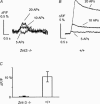Visualization of transmitter release with zinc fluorescence detection at the mouse hippocampal mossy fibre synapse
- PMID: 15919713
- PMCID: PMC1464795
- DOI: 10.1113/jphysiol.2005.089276
Visualization of transmitter release with zinc fluorescence detection at the mouse hippocampal mossy fibre synapse
Abstract
Exocytosis of synaptic vesicle contents defines the quantal nature of neurotransmitter release. Here we developed a technique to directly assess exocytosis by measuring vesicular zinc release with the zinc-sensitive dye FluoZin-3 at the hippocampal mossy fibre (MF) synapse. Using a photodiode, we were able to clearly resolve the zinc fluorescence transient ([Zn2+]t) with a train of five action potentials in mouse hippocampal brain slices. The vesicular origin of [Zn2+]t was verified by the lack of zinc signal in vesicular zinc transporter Znt3-deficient mice. Manipulating release probability with the application of neuromodulators such as DCG IV, 4-aminopyridine and forskolin as well as a paired train stimulation protocol altered both the [Zn2+]t and the field excitatory postsynaptic potential (fEPSP) coordinately, strongly indicating that zinc is co-released with glutamate during exocytosis. Since zinc ions colocalize with glutamate in small clear vesicles and modulate postsynaptic excitability at NMDA and GABA receptors, the findings establish zinc as a cotransmitter during physiological signalling at the mossy fibre synapse. The ability to directly visualize release dynamics with zinc imaging will facilitate the exploration of the molecular pharmacology and plasticity of exocytosis at MF synapses.
Figures





References
-
- Assaf SY, Chung SH. Release of endogenous Zn2+ from brain tissue during activity. Nature. 1984;308:734–736. - PubMed
-
- Atar D, Backx PH, Appel MM, Gao WD, Marban E. Excitation-transcription coupling mediated by zinc influx through voltage-dependent calcium channels. J Biol Chem. 1995;270:2473–2477. - PubMed
-
- Baron A, Schaefer L, Lingueglia E, Champigny G, Lazdunski M. Zn2+ and H+ are coactivators of acid-sensing ion channels. J Biol Chem. 2001;276:35361–35367. - PubMed
-
- Betz WJ, Bewick GS. Optical analysis of synaptic vesicle recycling at the frog neuromuscular junction. Science. 1992;255:200–203. - PubMed
-
- Buhl EH, Otis TS, Mody I. Zinc-induced collapse of augmented inhibition by GABA in a temporal lobe epilepsy model. Science. 1996;271:369–373. - PubMed
Publication types
MeSH terms
Substances
Grants and funding
LinkOut - more resources
Full Text Sources

